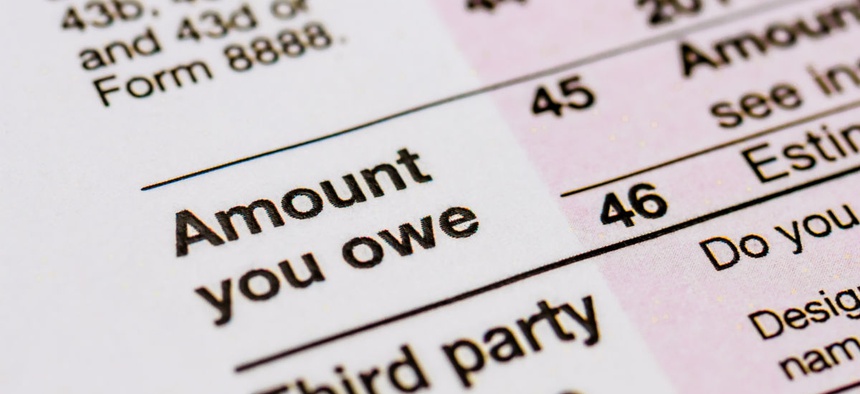Not many things in life can be more stressful than owing the IRS money, particularly if you can’t easily lay your hands on it. Fortunately, you have a few options when this happens. It becomes a matter of determining what’s best for your personal situation.
Tax Debt Can Snowball Quickly
Keep in mind that tax debt can get out of hand quickly if you procrastinate about dealing with it. The IRS will tack on penalties and interest to your outstanding balance.
Let’s say you owe the IRS $30,000 for your last two years’ tax returns. You consider going back and amending one or both of them to take advantage of tax deductions you might have overlooked. That’s a good first step, but late penalties and interest are piling on while you debate this option and finally get around to filing two new returns.
You might shave a little off that tax debt by amending your returns, but the interest and penalties assessed by the IRS might offset any savings that may have deducted. It might benefit you more to address the debt first. Your balance owed can be adjusted later if it turns out you don’t owe that much.
Consider an Installment Agreement
The IRS will approve an installment agreement to settle the debt if the taxpayer has filed all tax returns for the last five years and the total balance owed for all years is less than or equal to $50,000.
You would qualify for a streamlined installment agreement if your balance due is $30,000. “Streamlined” simply means that the IRS won’t ask about your current financial situation. You’ll have fewer forms to fill out.
Had you owed less than $10,000, you would have qualified for a guaranteed installment agreement payable over three years.
Qualifying for a streamlined agreement gives you six years.
Minimum Payments
The streamlined agreement depends upon you being able to pay a minimum of about $415 a month, every month: your total tax debt divided by 72 months. You can always pay more in each month, but you can never pay less than the amount you agree to.
You could set up an installment agreement for $450 per month or $515 per month, as long as the amount is at least the $415 minimum payment. But it’s generally advisable to set up your installment agreement for the minimum amount the IRS will accept, then pay extra whenever you can. You’re not limited to your minimum payment. You can pay more voluntarily.
What Happens If You Can’t Afford the Minimum?
You’ll have to contact the IRS to work out a different payment arrangement if you can’t afford the minimum. You must submit Form 9465 rather than apply online and a thorough financial analysis becomes necessary. The IRS will want to know:
- How much money could you come up with to pay your tax debt if you were to sell all your assets? Measure the current value of your assets and subtract any loans against those assets.
- Do you have available credit? Could you borrow money through a credit card or home equity loan to pay the IRS?
- How much money do you have left over each month after you pay your necessary living expenses? This is how much the IRS will expect you to pay every month if you can’t manage the minimum payment.
Not Every Expense Will Count
The critical question is usually how much money you have left over each month after paying your necessary living expenses. Let’s say you earn $4,600 per month in wage income. You must spend $4,350 on living expenses. You have $250 left over each month.
This net difference between your monthly income and your monthly expenses is what the IRS would look for in a payment plan. You can complete IRS Form 433-A or Form 433-F to help you make these calculations, but here’s where it gets tricky.
The IRS might not allow all your expenses. It can disregard certain spending for two reasons: The expense isn’t necessary or it’s higher than average.
This might be the case if you spend $250 a month on the best available cable or streaming package. Is this a necessity? The IRS would say no. You could live a perfectly reasonable lifestyle with basic cable. That $250—or, more likely, $150 of that $250 because paying for some form of cable is acceptable—could go to the IRS instead.
Necessary Expenses
According to the IRS, necessary expenses are those that “are necessary to provide for a taxpayer’s and his or her family’s health and welfare and/or production of income.” They include:
- Food, groceries, clothing, housekeeping and personal care items.
- Housing and utilities. This includes rent, mortgage payments, property taxes, and homeowner’s or renter’s insurance. It also includes telephone service, trash, water, gas and electric, propane, some cable television, and internet service.
- This includes car payments, gasoline, oil changes, maintenance and repairs, and auto insurance. It also includes public transportation such as bus passes, train, and other mass transit fares.
- Health insurance premiums and out-of-pocket medical expenses.
- Child care.
- Term life insurance premiums.
- Estimated tax payments and withholding for the current tax year.
- Installment payments for past due state and local taxes.
- And other expenses if they can be shown to be necessary for health, welfare, or the production of income.
Collection Financial Standards
The IRS will compare your actual spending to averages that vary by region to take into account that some areas have higher costs of living than others. These expense averages are called collection financial standards. The IRS will assume that you need to spend only up to the amount specified by the collection financial standards. Anything over and above that amount is discretionary rather than necessary.
Your mortgage might be $3,000 a month, but if the standard in your area is $1,500, the IRS will most likely add $1,500 back to your disposable income.
The IRS will review your financial documents, including bank statements and pay stubs and other documents, to verify your income and spending if you can’t commit to paying your entire balance off in 72 months.
Other Options
You have a few other options if the IRS isn’t willing to accept the amount you think you can comfortably pay:
- Sell assets to generate some ready cash to pay to the IRS.
- Take out a loan or use credit cards to pay the IRS.
- Request an offer in compromise—a proposal to pay the IRS less than the full amount due.
- Ask for a deferment where the IRS would agree that you don’t have to make payments until your financial situation improves.
Sometimes, the right answer is a mix of these options.
Get Your Tax Relief Questions Answered Today
Do you feel you’re in need of tax relief help? Know that Anthem Tax Service is here to assist you in getting the relief you need and deserve. Contact us today to learn more about your rights as a taxpayer or business owner.


